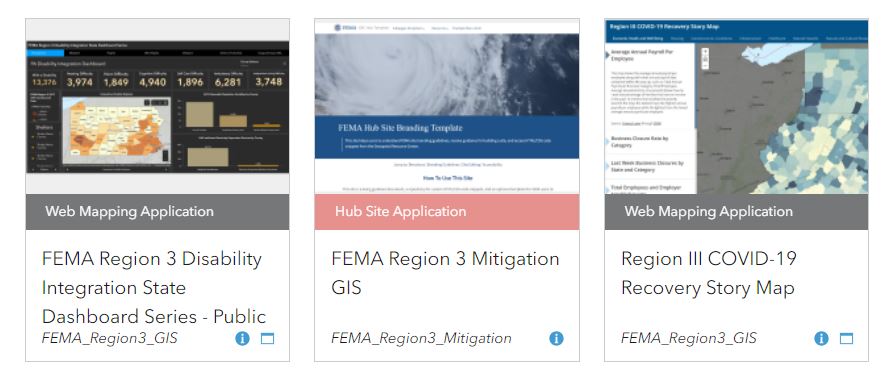States
Leadership
Environmental Resources
Mitigation Planning
Contact Us
News
FEMA's Region 3 office, located in Philadelphia, PA, partners with federal emergency management for seven Tribal Nations and the following states.
States
Visit the state/territory's page for localized content, such as disaster recovery centers, flood maps, fact sheets, jobs and other resources.
Leadership

Acting Regional Administrator

Acting Deputy Regional Administrator
Environmental & Historic Preservation Resources
FEMA funded projects must undergo Environmental and Historic Preservation (EHP) review to ensure we protect and preserve our natural and historic resources.
These tools help explain the federal environmental and historic resource laws and Executive Orders. They provide guidance specific to Region 3 states for the EHP compliance portion of the grant application process.

EHP Checklist
Use the EHP Checklist to learn what's required to complete an EHP review, plus common reasons for additional requests for information.
EHP Photo Guide
Learn how to take photos that help EHP understand your project and reduce additional requests for information.

Environmental Assessments
View Region 3 documents, including draft and final environmental assessments and public notices.
Video Tutorials
View these short, easy-to-understand 15-minute videos to learn the basics about the EHP review.
Have EHP Questions?
Contact Federal, State & Tribal Governments
Find contact information for federal and state partners and tribal nations that work alongside Region 3 EHP as applicant liaisons and consulting agencies during environmental and historic preservation law reviews.
NOTE: This list was updated as of Dec. 2022 and should not be considered a complete list.
Contact EHP
Email Tessa Nolan, Regional Environmental Officer
Hazard Mitigation Resources
The resources below can help your state or community develop a hazard mitigation plan, request technical assistance, find flood information, and use mapping tools to reduce risk.
Visit the Region 3 Mitigation GIS and Data Hub for maps and data that support hazard mitigation.
Topics
Use the search filters below to find resources on:
- State and local hazard mitigation planning
- Planning for high hazard potential dams
- GIS tools for reducing flood risk
- Training and technical assistance opportunities
National-Level Resources
Request Training
Review the Hazard Mitigation Course Catalog for information on all of the external training courses currently available through FEMA R3.
Fill out this contact form to request training or technical assistance for your community.
Local floodplain managers can use this worksheet to help them meet and exceed the requirements of the National Flood Insurance Program (NFIP). It can be used to help meet hazard mitigation planning requirements or to build local resilience to flooding. Meeting NFIP requirements unlocks access to federal flood insurance, grants and loans.
Hazard mitigation planning teams can use this worksheet to guide them through an effective capability assessment. Knowing your community’s regulatory, technical and financial resources can help identify and implement strong mitigation actions.
Use this checklist to help with annual reviews of local hazard mitigation plans. A hazard mitigation plan is a living document. Reviewing it each year can keep information current and partnerships strong.
To be eligible for certain FEMA grant funding programs, all participating jurisdictions and special districts need to adopt the plan within one year of FEMA approval
Use this worksheet to help your community develop a detailed and actionable flood risk assessment. Flooding is the most common natural disaster in Region 3. It destroys thousands of homes and costs billions of dollars each year.

Tip: Speak with a FEMA Region 3 Planner to help you complete this worksheet!
Connect with Region 3

Coffee Break Webinars
Attend a Region 3 “Coffee Break," a one-hour webinar showcasing mitigation best practices and highlighting the work to reduce risk across the region. Reserve a spot.
Resilience Report Newsletter
Sign up to receive project highlights, best practices and upcoming events focused on mitigation, risk reduction, and increasing resilience.

Regional Business Emergency Operations Center
Region 3's Business Emergency Operations Center helps connect FEMA and the private sector throughout pre-disaster preparedness, disaster response and post-disaster recovery. Learn more and join.

Region 3 Case Studies
View case studies sharing successes and lessons learned from Region 3 states.
Recovery Forward Newsletter
Sign up to the Recovery Forward Newsletter.
Contact Us
General
215-931-5500
Congressional
FEMA-R3-CongQ@fema.dhs.gov
Exercise Officer
FEMA-R3-Exercises@fema.dhs.gov
Grants
FEMA-R3-Grants-Division@fema.dhs.gov
News Desk
215-931-5597
FEMAR3NewsDesk@fema.dhs.gov
Private Sector
FEMA-R3-Private-Sector@fema.dhs.gov
Tribal Affairs
FEMA-R3-Tribal@fema.dhs.gov
Hazard Mitigation Planning
fema-r3-hm-planning@fema.dhs.gov
Flood Insurance
FEMA-R3-NFIP@fema.dhs.gov



